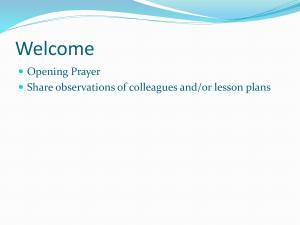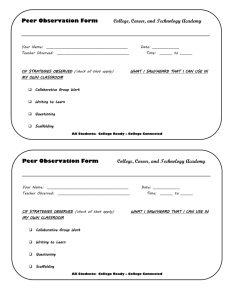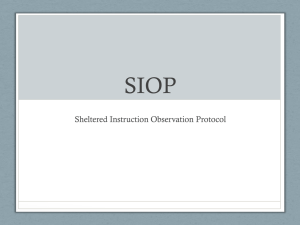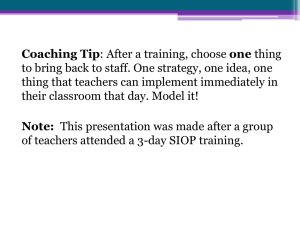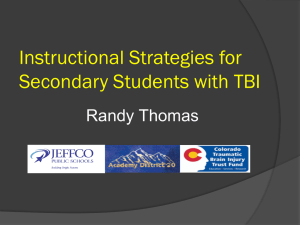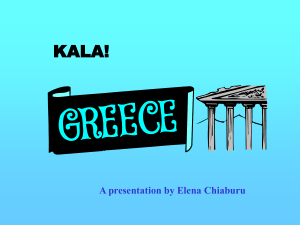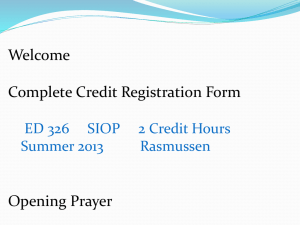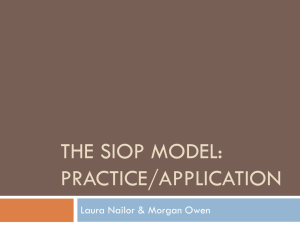Session # 4: Strategies
advertisement
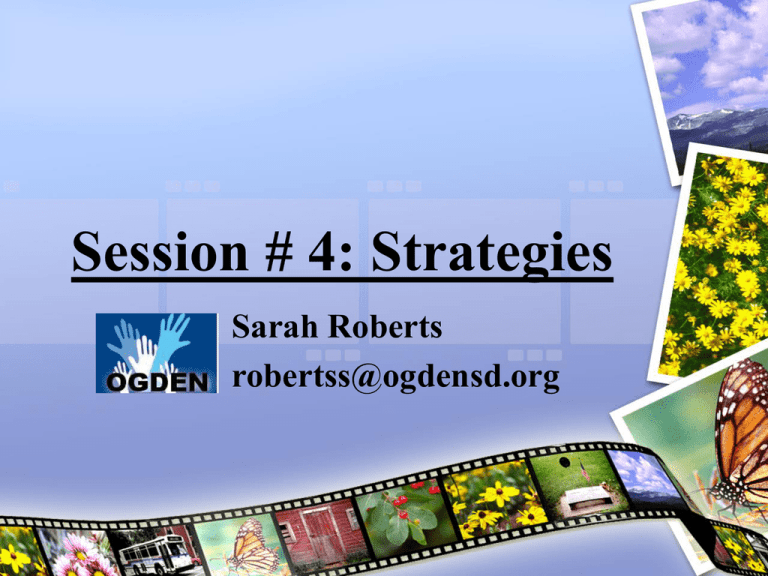
Session # 4: Strategies Sarah Roberts robertss@ogdensd.org Presenter Background “In times of change, learners inherit the earth, while the learned find themselves beautifully equipped to deal with a world that no longer exists.” ~Eric Hoffer, philosopher Objectives • Content Objectives: – Identify appropriate learning strategies appropriate to a lesson’s objectives. – Incorporate explicit instruction and student practice of metacognitive and cognitive strategies into lesson plans. – Recognize the value of scaffolding instruction and identify techniques to scaffold for verbal, procedural, and instructional understanding. • Language Objectives: – Discuss language learning strategies to use with students. – Discuss the importance of asking higher-order questions to students of all proficiency levels. – Write a set of questions with increasing levels of difficulty on one topic. Quick Write Brainstorm • Write a list of the strategies that you personally employ when you come across a word or information that you do not understand. • Explain how you teach students to employ these or similar strategies. Quick Write Exchange 1. Exchange papers with a partner. 2. Write a one sentence response to his/her paper. 3. Return the paper to the owner. 4. Write a one sentence summary of all information written between you and your partner. SIOP Strategies • The purpose of the SIOP Strategies section is to examine our strategy instruction, not just the strategies that we employ. • The purpose of strategy instruction is to help students to access memory, make connections, solve problems, and monitor their own learning. Strategy Categories BLM #1 Metacognitive Cognitive Scaffolding Techniques Questioning Techniques Explicit Teaching Techniques Experiential Techniques Social/Affective Continuum of Strategies, BLM #2 1. Individually brainstorm strategies for each of the four categories. 2. Share your list with a partner. Add any strategies from their list that you had not considered. 3. Share your list with a group. Add any new strategies suggested or generated in your discussion. Continuum of Strategies Charts • Add any and all strategies generated by your group to the following charts around the room: – – – – Teacher-Centered Strategies Teacher-Assisted Strategies Peer-Assisted Strategies Student-Centered Strategies TESOL Standards, p. 83 • Goal 1, Standard 3: Students will use learning strategies to extend their communicative competence. • Goal 2, Standard 3: Students will use appropriate learning strategies to construct and apply their academic knowledge. • Goal 3, Standard 3: Students will use appropriate learning strategies to extend their socio-linguistic and socio-cultural competence. CALLA: The Cognitive Academic Language Learning Approach Integration of Content, Metacognition, and Cognition for Strategic Academic Success Metacognitive Strategies: Planning Monitoring Evaluating Social/Affective Strategies: Questioning for Clarification Cooperation Self Talk Cognitive Strategies: Resourcing Grouping Note-taking Elaboration Summarizing Deduction/Induction Imagery Auditory Representation Making Inferences Scaffolding Approach Teaching by Example Scaffolded Groupings Teach Whole Class Model Small Group Practice Partners Apply Independent Work Common Scaffolds • • • • • • Contextualization Modeling Bridging Text Re-Presentation Schema Building Metacognitive Strategy Instruction Questioning Techniques • Bloom’s Taxonomy: – – – – – – Knowledge Comprehension Application Analysis Synthesis Evaluation Explicit Teaching • Give every detail, specific, purpose, and objective: – Who, What, When, Where, Why, and How? Experiential Techniques • Facilitated realistic applications and discovery of skills: – – – – Discovery Experimentation Trial and Error Risk-Taking GIST, BLM #3 • Get It Summarized Today/Together – Each group is responsible to complete the GIST for one of the following concepts (as assigned) using the SIOP book, the BLM’s, handouts, etc.: • • • • • CALLA Strategy Instruction Scaffolding Strategies Questioning Strategies Explicit Techniques Experiential Techniques Video Observation SIOP’s Strategy Component Looks Like Sounds Like Feels Like Putting It Together 1. Read the poem “Silence.” 2. With a partner or group, write a content or language objective including one or two appropriate learning strategies to teach/practice/review. 3. Write one question for each of Bloom’s Taxonomy levels in alignment with your lesson. 4. Share your lesson “plans” with the whole group. Well, … “You’ll notice that many of the recommended practices for children learning a second language parallel our recommendations for all students. Though all kids benefit from them, children learning a second language depend on these practices. Without them, school can be a confusing and frustrating place. With these practices, school makes sense for second language learners and they join their classmates in learning throughout the day.” ~Stephan Cary
